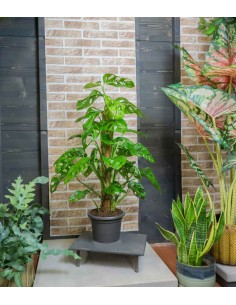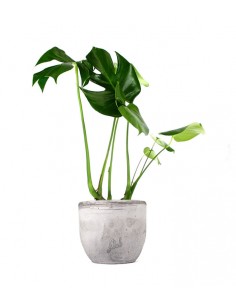- Green Lifestyle
- 123926 views
- 0 comments
We all know it under the name of Monstera: this fantastic plant which, by now, is becoming very popular in interior design, is actually the one that in botanical language belongs to the Philodendron family. It's also your favorite, we know, but what is hidden behind its strange leaves? Let's talk a little more in depth!
A little bit of curiosity
First of all you must know that the nickname "Monstera" was assigned by the French botanist Adanson in 1763, and refers both to the appearance of the leaves and their size: when they grow, from the original "heart" shape they fracture and take on a very strange, almost monstrous and even reach the meter in length! Sometimes these splits originate from the center but do not reach the edge of the leaf, so much so that the latter looks like holes in it. Wanting to be more fussy, its precise name would be in fact Philodendron Pertusum: the latter Latin adjective means precisely "perforated".
In Guatemala, where it reaches 6-7 meters in height, it is even considered divine and is used in this regard as a "fan" capable of driving out evil spirits in certain religious ceremonies.
Would you ever say that this Philodendron is a creeper? When it is grown, its aerial roots become very showy (in nature it grows in the rain forests, attached to the trunks of the trees) so as to constitute a sort of "jungle" inside a single vase. Although it is a rare occurrence in indoor cultivation, the plant can flower and even make a fruit, which in shape is similar to a banana and in taste is similar to pineapple!
Where can we place it? It is soon said: practically everywhere. The Monstera stands out for being one of the indoor plants that live well even in low light. It has no problem growing in poorly lit areas and that's why we often find it in closed rooms such as offices, bars, waiting rooms ... as well as in our homes. Consider that it is even advised to remove this plant from points of light in winter. Also because it needs at least 2 square meters of space, otherwise if it grows against walls and windows it suffers, and develops in an awkward way.
However, it is an evergreen that has few cultural needs, and that if well preserved will live up to 30 years. Just keep the soil constantly moist (but avoiding stagnation) and spray its leaves with non-calcareous water to recreate the right environmental humidity. The Monstera Philodendron resists well up to 30 ° C, being native to Mexican regions. It does not even need many fertilizations: from 3 to 4 per year in period of vegetative growth.
A plant that cleans the air
The Monstera It is not only an ornamental indoor plant, because its use in enclosed spaces is also useful to make us breathe better. Several studies have shown that the Philodendron Monstera deliciosa is able to absorb up to 80% of the pollutants present in the air, in particular formaldehyde (found for example in furniture paints) and benzene (cigarettes contain a large quantity : in the apartments of smokers can therefore be of considerable support!).
It is a simple mechanism, and at the same time incredibly effective: it has tiny openings on the leaves (invisible to our eyes) with which the toxic substances are "captured" and rendered inert and accumulated in the cell walls. In essence, the Philodendron Monstera and many other plants act as real natural filters, retaining within themselves all that is harmful. Do you want to find out what are the other indoor plants that do the same thing? Take a look at the article we had dedicated to it: Healthy plant, let's clean!
Now we have clarified a little ideas on this fantastic houseplant, which in addition to being aesthetically fascinating plays a considerable role against domestic pollution.
You just have to choose whether to place it in the living room, in your study, in the corridor or in your office: in any case, it will certainly make an excellent effect!







Comments (0)